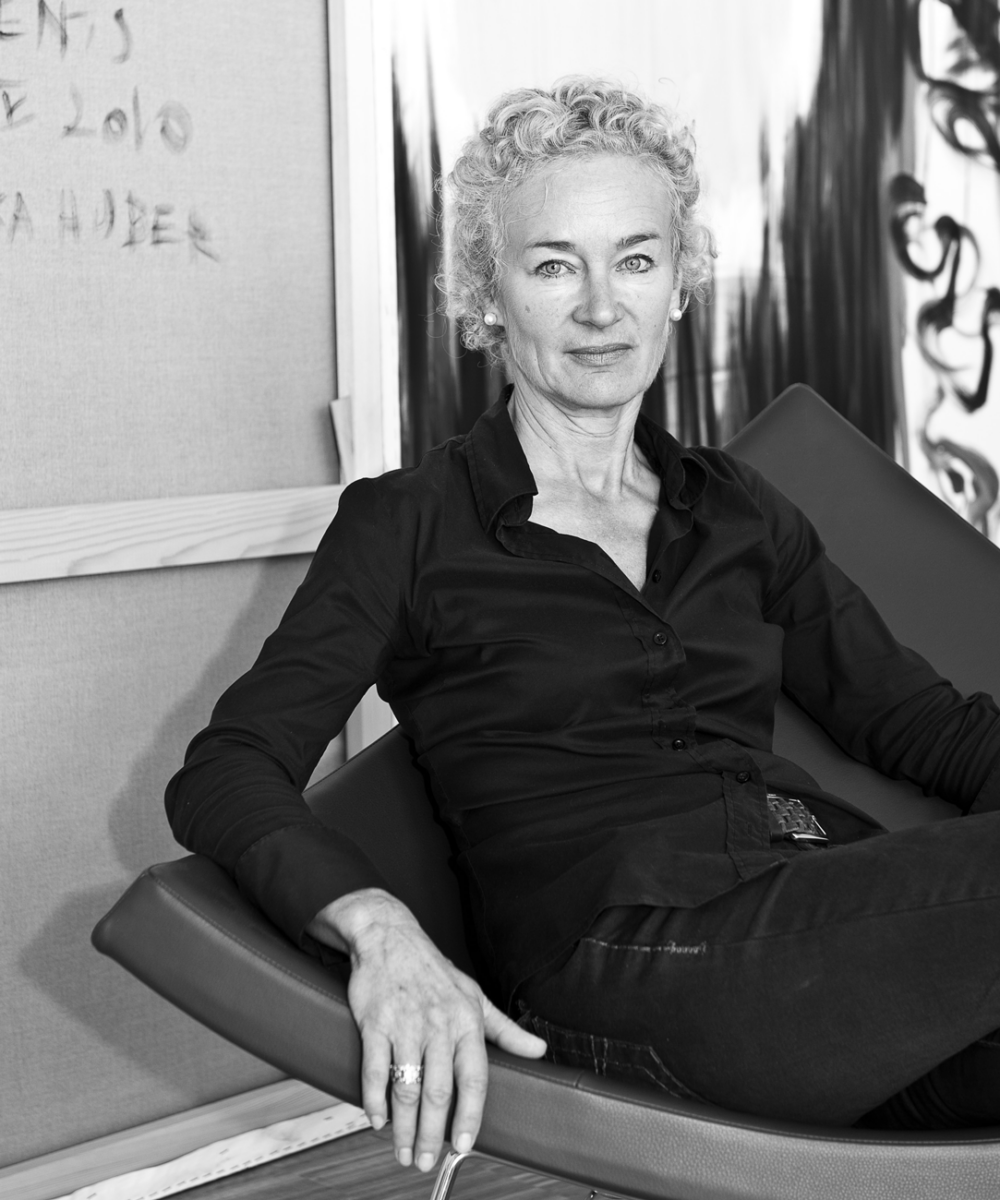Ika Huber
1985–2016 ATELIERS
in München, Freiburg & Colombier (CH)
1974–80 STUDIUM DER MALEREI
an der Akademie der Künste Karlsruhe bei
Peter Dreher und Georg Baselitz
1993
Heirat mit Günther Förg
The paintings give the overall impression of fragments – meaning that they originate as fragments. At some point came the first touch of paint at a random spot on the canvas as an extension , in a way, of memories of landscapes, buildings, inner courtyards and windows, light as a feather – and so, as such, fragmentary; as fragmented and haphazard as memory itself.
Individual elements assume at times the completeness of a figure or the solidity of a column; straight lines are, however, meticulously avoided. Colours are mostly thin, but applied in delicate layers; the broad brushstrokes remain visible, creating a veiled effect but also one of restless vibration, like warm air over a horizon. In places, too, the paint is sometimes rubbed on dry and brittle, giving it the appearance of chalk. There is so much to see in these paintings if you examine them more carefully: hundreds of details make the picture glow like night.
Straight lines are avoided then, as these tend to trap colours and forms within their rigid framework. But the figments of memory which lead to fragmentary pictures should surely float if anything. This is what makes the drawing in these paintings so remarkable. The forms do indeed have contours but they are very hesitantly, almost unwillingly, suggested.
The forms are intertwined with each other with extraordinary care, as if Ika Huber was reluctant to say what the memory is. She leads the eye towards something else which must be seen, I think, in the same indescribable movement as that of Leonardo da Vinci’s Lady with an Ermine just over 500 years ago.
It is the mysterious and unfathomable that always confronts me in these pictures; in their composition, their details, the resonance and tone of their colours, and in their dreamlike mobility and “Sfumato”. There is a lot here then which does indeed complete the fragments in the pictures – but the question remains: to what extent.
Rudi Fuchs, Den Haag
Die Gemälde erscheinen allesamt wie Fragmente – das heißt, sie sind als Fragmente begonnen, irgendwo war die erste Bewegung der Farbe auf dem Tuch, an einer willkürlichen Stelle und sozusagen als Verlängerung der Erinnerung an Landschaften, Gebäude, Innenhöfe, federleichte Fenster und von daher also fragmentarisch, so fragmentarisch und zufällig wie die Erinnerung selbst. Einzelne Formen haben zuweilen die Fülle einer Gestalt oder die Stämmigkeit einer Säule, gerade Linien aber werden sorgfältig vermieden.
Die Farben sind meistens dünn, aber in zarten Lagen übereinander angebracht, die breiten Pinselstriche bleiben sichtbar, was den Effekt von Schleiern erzeugt, aber auch den Effekt einer unruhigen Vibration, wie heiße Luft über dem Horizont. Manchmal ist die Farbe auch trocken und bröckelig an bestimmten Stellen ausgeschmiert, was wie Kreide aussieht. Es gibt so viel zu sehen in diesen Gemälden, wenn man sie länger betrachtet: Hunderte von Einzelheiten lassen das Bild funkeln wie die Nacht.
Gerade Linien werden also vermieden, da diese dazu neigen, Farben und Formen in ihren starren Rastern einzufangen. Die Bruchstücke der Erinnerung aber, die zu fragmentarischen Bildern führen, müssen eigentlich eher schweben. Daher ist die Zeichnung in diesen Gemälden auch so wunderlich. Die Formen haben zwar schon eine Kontur, aber die ist ganz zögernd angegeben, fast unwillig.
Die Formen gehen mit außerordentlicher Vorsicht ineinander über, als wolle Ika Huber lieber nicht sagen, wovon die Erinnerung handelt. Sie wendet den Kopf zu etwas, was noch gesehen werden muß, denke ich, in derselben unbeschreiblichen Bewegung wie die der Dame mit dem Hermelin vor etwas mehr als 500 Jahren ( Leonardo da Vinci )
Es ist das Geheimnisvolle und Unergründliche, das ich immer in diesen Bildern sehe: in ihrem Aufbau, in ihren Details, im Klang und im Ton der Farben, in der träumerischen Beweglichkeit und dem „Sfumato“. Es ist also vieles da, das die Fragmente in den Bildern dann doch vervollständigt – nur inwieweit bleibt die Frage.
Rudi Fuchs, Den Haag

